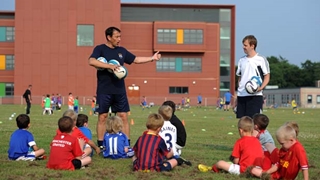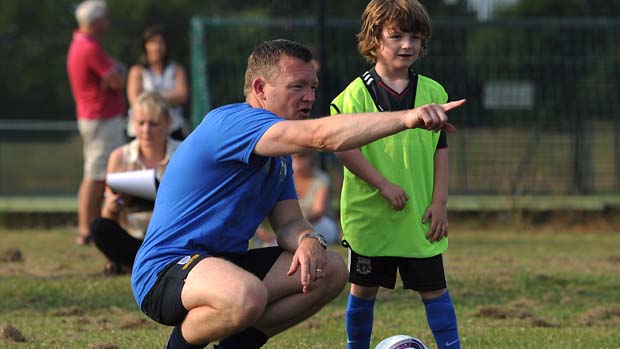
By Nick Levett
It’s a hot topic in youth football that rears its head regularly, not one that’s as contentious as sideline behaviour or the intricacies of coaching, but still vital in the scope of player development.
Take these players for example:-
Player 1: over 75 England caps, over 400 Premier League games at centre back.
Player 2: over 100 England caps, over 400 Premier League games at centre midfield
Player 3: over 100 England caps, over 400 Premier League games at left back
Player 4: over 50 England caps, over 400 Premier League games at centre forward
What have they all got in common, other than fantastic careers?
Well, all of them throughout their youth career played in a different position to the one they made full-time careers in.
Player 1 spent most of his time in centre midfield or as a forward, Player 2 played most of his youth football as a defender or wide player, Player 3 played as a striker and winger most of the time and Player 4 played as a winger.
For young players, the benefits of playing in different positions are massive. Developing a whole round game understanding is a vital part of the education of young players and something that as adults we can help develop reasonably easily. To develop pictures in your mind of different scenarios linked to things that might occur in the game is really important.
“For young players, the benefits of playing in different positions are massive.”
Nicl Levett FA National Development Manager
For example, I played my main football career at full-back and had all the game on the inside of me, nothing to consider elsewhere and developed certain pictures in my head of how to play.
I have now dropped down a few levels and playing for my friend’s team, he asked if I could play in the centre midfield. WOW! I need a map to play in there!
The game is going on behind me, on both sides as well as in front of me and having never been exposed to understanding how to play in different positions, I find it a real struggle.
It’s just so different. Equally, when there had been injuries in other games and I was asked play in a different position, I simply never had the experience to perform well enough in a different role for the team.
We need to allow players the flexibility to be able to play in different positions and ensure they recognise that it is in their best interests of helping them get better. As a coach, that is our role, to focus on the long term player development. This is a story from one of our senior FA coaches;
"I’d worked with the team for a few years and got them to a position that they could take ownership for their own development. It was an U18 fixture and I can recall our centre forward after the first period coming over and saying “please can I play in centre defence next quarter?” I replied: “Of course, but I need a reason why.”
The player replied: “I have seen their striker causing problems for our defenders and would like to play against him to see if I can learn from his movement to then use it in my own game."
Two things strike me from that story. The first is how smart the player is to recognise that he can learn things to develop his own game and puts the development of that above winning the match or scoring goals right now.
The second is how good the coach must have been to have worked with the team to allow them that mindset and to take risks in the game for their development, over and above the outcome of the game.
The challenge is to get past our own ego first though. We have to put aside the score sometimes and recognise that we have to put the player’s needs first.
This has to be done on several levels; first of all, managing our own expectations about when things might not go as well on a ‘team’ basis as it would do when playing all our best players in their best positions, and also managing the parents.
This is an education aspect, for the parents and the players. Once the children know it will help them become a better player, they may grumble a little but they will understand as long as you are consistent with all the players.
You can’t then play your son or daughter as striker every game if you have declared a policy on rotation of positions. Equally, managing the parents is an important aspect too, explaining to them why you are doing this and the rationale behind this is imperative. If you suddenly just spring this approach on them without forewarning there is likely to be a bit of push back from them, so explain to them the approach at the start of the season.
So what are the options in terms of rotating positions? It will depend on the format of football you are playing and the number of players you have available of course. The challenge is developing a policy you are comfortable with that meets the needs of the children and the club. Some questions to consider:-
How often do players play in a different position?
What information do you give them prior to the game about different roles and responsibilities?
What games do you select players to play in different positions? Tough games or easier games?
How many positions will they play in a season?
How long will they spend in one position to start to understand this before trying a different one?
There are lots of different ways to approach this and as a coach it’s important you understand what and why you are taking the approach that you are.
For example, what are the benefits and trade-offs of playing a predominantly left-footed player on the right side of the pitch? How do you manage this before you put them there? Do you show them YouTube clips of Lionel Messi and explain the benefits of being able to cut in to dribble and shoot? Do you show clips of Steven Gerrard scoring goals with both feet to highlight the importance of being two-footed and practising your weaker foot?
How do you manage the self-esteem of the player when they go down the right wing and then kick it off the pitch because their weaker foot isn’t very good? How do you manage the other players and parents when they kick it off the pitch? (The answer is you praise them for being brave and trying their weaker foot!)
There are lots of things to consider, it’s not simply a case of dropping players into different roles and expecting great returns. Things take time to learn and develop. Top developing professional clubs recognise this too – Ajax, for example, rotate youth players around a triangle of three roles in one season; playing right back, right centre back and right midfield in their 4-3-3 system.
So the challenge for you as a coach is not to pigeonhole children from a young age. Just because they are big today doesn’t mean they will always be the biggest and therefore they don’t always have to play in central defence.
Develop a policy with your club, involving all the different groups to do what is best in the development of the players.
That simply has to be the focus – developing a long term love of football and an all-round ability to play in our wonderful team game.






